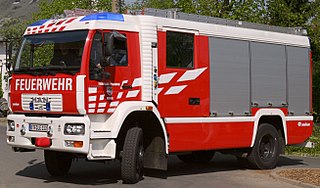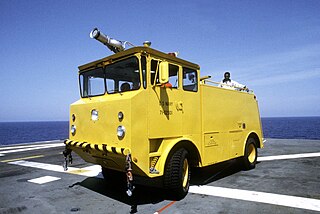
A fire engine or fire truck is a vehicle, usually a specially-designed or modified truck, that functions as a firefighting apparatus. The primary purposes of a fire engine include transporting firefighters and water to an incident as well as carrying equipment for firefighting operations in a fire drill. Some fire engines have specialized functions, such as wildfire suppression and aircraft rescue and firefighting, and may also carry equipment for technical rescue.

A fire hose is a high-pressure hose that carries water or other fire retardant to a fire to extinguish it. Outdoors, it attaches either to a fire engine, fire hydrant, or a portable fire pump. Indoors, it can permanently attach to a building's standpipe or plumbing system.

A fire hydrant, fireplug, firecock (archaic), hydrant riser or Johnny Pump is a connection point by which firefighters can tap into a water supply. It is a component of active fire protection. Underground fire hydrants have been used in Europe and Asia since at least the 18th century. Above-ground pillar-type hydrants are a 19th-century invention.

Firefighting is a profession aimed at controlling and extinguishing fire. A person who engages in firefighting is known as a firefighter or fireman. Firefighters typically undergo a high degree of technical training. This involves structural firefighting and wildland firefighting. Specialized training includes aircraft firefighting, shipboard firefighting, aerial firefighting, maritime firefighting, and proximity firefighting.

A draft is the use of suction to move a liquid such as water from a vessel or body of water below the intake of a suction pump. A rural fire department or farmer might draft water from a pond as the first step in moving the water elsewhere. A suction pump creates a partial vacuum and the atmospheric pressure on the water's surface forces the water into the pump, usually via a rigid pipe or a semi-rigid hard suction hose.
Firefighting jargon includes a diverse lexicon of both common and idiosyncratic terms. One problem that exists in trying to create a list such as this is that much of the terminology used by a particular department is specifically defined in their particular standing operating procedures, such that two departments may have completely different terms for the same thing. For example, depending on whom one asks, a safety team may be referred to as a standby, a RIT or RIG or RIC, or a FAST. Furthermore, a department may change a definition within its SOP, such that one year it may be RIT, and the next RIG or RIC.
This glossary of wildfire terms is a list of definitions of terms and concepts relevant to wildfires and wildland firefighting. Except where noted, terms have largely been sourced from a 1998 Fireline Handbook transcribed for a Conflict 21 counter-terrorism studies website by the Air National Guard.
This is a glossary of firefighting equipment.

The Feuerwehr is a number of German fire departments. The responsible bodies for operating and equipping fire departments are the German communities ("Gemeinden") and cities ("Städte"). By law, they are required to operate fire-fighting forces. In cities, this is usually performed by the Fire Prevention Bureau, one of the higher-ranking authorities.
Firematicracing is a proprietary name for a type of recreational competition among the firefighter teams involving timed completion of tasks related to or simulating common firefighting activities. The sport under its present name is most popular on Long Island, and other parts of New York State, although similar types of competition, known under different names, exist in other parts of the world.

A wildland fire engine or brush truck is a fire engine specifically designed to assist in fighting wildfires by transporting firefighters to the scene and providing them with access to the fire, along with water or other equipment. There are multiple types of wildfire apparatus which are used in different scenarios. According to the U.S. National Fire Protection Association, if the apparatus will be used primarily for outdoor and wildland responses, then it is to be considered a wildland fire apparatus and must conform to NFPA 1906.
The San Diego Fire-Rescue Department (SDFD) is the full-service fire department of San Diego, California. It was established on August 5, 1889. The department responds to over 183,000 calls per year. It covers 343 square miles of service area, including 17 miles of coastline. It is the second-largest municipal fire department in California, after the Los Angeles Fire Department.

Helitack crews are teams of wildland firefighters who are transported by helicopter to wildfires. Helicopters provide rapid transport, enabling helitack crews to quickly respond and assess a wildfire situation. Helitack crews may land near a wildfire or, if equipped and trained, rappel from a hovering helicopter. Once on the ground, crews build firelines using hand tools, chainsaws, and other firefighting tools. They often remain overnight in remote locations. After they have completed their assignment, crew members may pack up to 120 pounds of equipment over difficult terrain to reach a pick-up point. Rappellers often prepare helispots that provide better access to a fire. Helicopter crew members may also perform other duties such as tree falling, firing operations, and managing helibases.

The Kansas City Fire Department provides fire protection and emergency medical service for Kansas City, Missouri, and under contract to Village of the Oaks, Village of Oakwood Park, and Village of Oakwood. It provides fire protection only under contract to City of Lake Waukomis, City of Platte Woods, City of Weatherby Lake, and Village of Ferrelview. In addition, it provides EMS support under contract for the City of Riverside. It operates 35 fire stations, one dedicated EMS operations facility housing dynamically deployed ambulances, organized into seven battalions and cover 318 square miles (820 km2).

Fire services in the United Kingdom use a variety of fire appliances, which perform a wide range of general and specialised roles and fit into several distinct categories. Contemporary fire appliances carry a multitude of equipment and firefighting media to deal with different types of emergencies ranging from fires, rescues, vehicle extrication, floods, salvage, casualty and trauma care.

The San Antonio Fire Department provides fire protection and emergency medical services for the city of San Antonio, Texas. The department is the third largest fire department in the state of Texas. With over 1,800 members, the SAFD is responsible for a population of over 1.4 million people spread across 408 square miles (1,060 km2).

The Baltimore City Fire Department (BCFD) provides fire protection and emergency medical services to the city of Baltimore, Maryland, United States. Founded in 1797 and established in 1859, the Baltimore City Fire Department covers an area of 81 square miles (210 km2) of land and 11 square miles (28 km2) of water, with a resident population of over 640,000 and a daytime population of over 1,000,000. The BCFD responds to approximately 235,000 emergency calls annually. There are two International Association of Fire Fighters (IAFF) locals; IAFF 734 for firefighters and IAFF 964 for officers.

The Santa Barbara County Fire Department (SBCFD) provides fire protection and emergency response services for the unincorporated areas of Santa Barbara County, California, and for multiple cities within the county. Together, these areas compose the Santa Barbara County Fire Protection District.
John Morris & Sons Limited of Cross Lane, Salford, Manchester, Lancashire, were manufacturers of all kinds of fire fighting equipment from fire engines, manual then motorised, fire retardant foams, and electrical fire alarms, down to firemen's axes and fire buckets.

The Oshkosh MB-5 is a specialized aircraft rescue and firefighting (ARFF) vehicle built by Oshkosh Corporation for putting out fires on-board aircraft carriers. It was designed for rapid deployment of multiple firefighting media by a crew of 4, with a relatively compact design. However, What set this truck apart from other ARFF vehicles of the time was its ability to pump water while moving. This feature, along with its powerful 10.7 L Caterpillar diesel engine and four-wheel drive, made the MB-5 a staple of US military firefighting. It could be seen on US aircraft carriers and airbases both during and after the Vietnam War, continuing service for almost a decade after production of the truck stopped in late 1971 (unconfirmed).













